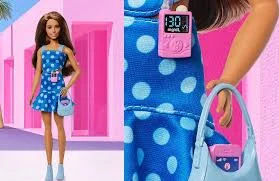- Web Desk
- 1 Hour ago

Mattel unveils first Barbie with type 1 diabetes, promoting inclusivity, representation
-

- Web Desk Karachi
- Jul 09, 2025

LONDON: Greta Gerwig’s Barbie movie showcases Barbieland as a space of equality and diversity. Although dolls have existed since 1959, it wasn’t until 2019 that Mattel began offering Barbies with physical disabilities. Now, the company has introduced its first Barbie doll representing type 1 diabetes, aiming to promote inclusivity and broaden children’s understanding of different experiences.
Type 1 diabetes is an autoimmune disease where the body attacks the insulin-producing cells in the pancreas. It is typically diagnosed in childhood, requiring daily monitoring of blood sugar levels and insulin administration.
The new Barbie, developed in collaboration with the global nonprofit Breakthrough T1D, features a continuous glucose monitor (CGM) on her arm, secured with pink heart-shaped medical tape. She also holds a mobile phone with a CGM app to track her blood sugar throughout the day. Additionally, the doll wears an insulin pump for automated insulin delivery and carries a spacious bag for essentials like snacks.
Krista Berger, senior vice-president of Barbie and global head of dolls, stated that the new doll represents “an important step in our commitment to inclusivity and representation.” She emphasized that Barbie influences children’s perceptions of the world and that including medical conditions like T1D helps children see themselves reflected in the toys they love.
‘This is my world’: Russia’s top Barbie fan sees herself in hit movie
Karen Addington, CEO of Breakthrough T1D UK, expressed her excitement, saying, “I’m thrilled that Barbie now features a doll with type 1 diabetes. For children with T1D who rarely see themselves represented, this doll will serve as a powerful role model, celebrating their strength and promoting inclusion and joy in play.”
Historically, Barbie dolls have evolved to include more diversity: the first Black dolls appeared in the 1960s, Hispanic dolls in the 1980s, and dolls representing various careers and underrepresented groups were added over the decades. Until six years ago, dolls with disabilities were absent. Today, over 175 styles are available in the Fashionistas range, showcasing different skin tones, eye and hair colors, body types, and disabilities—including dolls with vitiligo, prosthetics, wheelchairs, hearing aids, and blindness.
Other brands are also promoting diversity; for example, Lottie offers dolls with Down’s syndrome and autism, while Lego features minifigures with physical and invisible disabilities.
Commenting on the new Barbie, Arjun Panesar, CEO of diabetes.co.uk, said, “Representation matters—especially in childhood. Seeing a Barbie with type 1 diabetes helps normalize the condition, reduce stigma, and show children they are not alone. It’s a positive move toward greater confidence, inclusion, and understanding around living with diabetes.”





